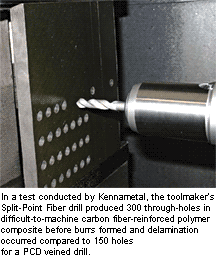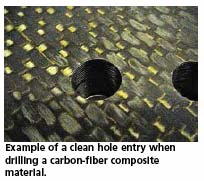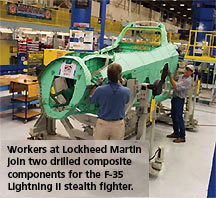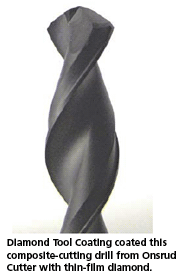

Composite Configurations Not all composites are created equal, though. “There’s quite a variety and all of them machine differently,” said Bob Maxey, vice president of business development for Onsrud Cutter LP. The Libertyville, Ill.-based company specializes in making cutting tools for machining composites. “Even within what the aerospace industry utilizes, there are a variety of different composite configurations. Even on some portions of an airplane, there are different types of composites.” According to Kennametal Inc., usage of one type of composite is growing: carbon fiber-reinforced polymer (CFRP) materials. “The big players are using this material for aircraft,” said Marcelo Campos, the Latrobe, Pa.- based toolmaker’s product manager for holemaking. “We are also seeing a movement to use CFRP for medical parts and by some automakers.” CFRP, or carbon fiber as it is commonly called, consists of strong, abrasive, reinforcing carbon fibers within a relatively soft polymer matrix. For other composites, the matrices include metal and ceramic, and the reinforcements include glass fibers and polymers. Kennametal stated that in CFRP, the polymer can be either thermoplastic or thermosetting, and epoxy, a thermosetting polymer, is the most common. Focus on the Fiber Crisscrossing fibers limit possible delamination and reduce the material’s sensitivity to thrust forces, but the tolerances for allowable delamination are tighter. (See table on page 51.) A material with unidirectional fibers requires applying a drill with sharp edges at a feed as low as 0.0015 ipr, Campos said. Kennametal recommends a 400-sfm cutting speed for producing a clean exit hole in difficult-to-machine composites and 450 sfm and a feed up to 0.004 ipr for improved productivity in easier-to-cut materials. When drilling composites that require a thrust force greater than 25 lbs., the speed and feed should be reduced. Bulk resin-infused composite, another type of carbon-fiber material, exhibits higher thrust forces because of the material’s high fiber density. Kennametal recommends reducing the speed and feed if a drill chips prematurely. Tool Time Because of the material’s abrasiveness, toolmakers discount using HSS tools. For carbide tools, Maxey recommends a grade with lower cobalt content for abrasion resistance and increased tool hardness to withstand high temperatures in the cut. A tool with less cobalt has reduced toughness, but a high level of toughness isn’t that critical when drilling composites because the tool experiences lower cutting forces than when cutting metal. Diamond Drilling The thickness of the resulting coating is 8 to 12 microns. The appropriate thickness depends on the application because drilling composites often requires sharp cutting edges and the thicker the coating, the more the edge rounding. “The concern is always edge rounding because when we remove some cobalt in our pretreatment process, carbide also falls away and then we’re putting a rather thick coating on that cutting edge,” Mueller said. “The end result is about 20 microns of edge rounding.” Because the diamond coating creates a radius on the cutting edge, Onsrud’s Maxey noted that a tool’s edge prep shouldn’t be more than 0.0005". “The key is to have as keen a cutting edge as possible, so the carbon fibers are cleanly sheared and not torn,” he said. Many end users may want to avoid the cost of a PCD-coated drill, but Mueller maintains that PCD coating is a wise tooling investment. “With an uncoated tool, they can’t drill an acceptable hole that has the quality they’re looking for,” he said. “With a diamond coating, they’re able to do that and do it 10 times as long.” Combination Cutter “Because of the high cutting force, there’s a lot of delamination when you use, let’s say, normal PCD drills,” Campos said. “It took more than a year trying different kinds of geometries and coatings to find the best combination.” The drill’s solid-carbide substrate is coated with a smooth CVD multilayer diamond coating. The tool’s low point angle reduces axial forces to minimize or eliminate delamination, and special point thinning increases the drill’s centering capability and reduces thrust to improve hole quality, according to Kennametal. In one Kennametal test pitting an SPF drill against a PCD-veined drill, the SPF tool drilled 300 1⁄4"-dia. through-holes in 0.3"-thick difficultto- machine CFRP plate before burrs formed and delamination occurred, compared to 150 holes for the other drill. The tools were run at a 400-sfm cutting speed and a 0.0015-ipr feed without coolant on a Makino A55 horizontal machining center. The tool also has a shank with an H6 tolerance to minimize TIR. “It needs to have low runout,” Campos said. “We suggest using this drill in a hydraulic chuck or shrink-fit holder, or if you use a collet, it needs to be a high-precision collet.” In addition, the SPF drill is for CNC machine applications. “It should not be used in hand tools or other manual devices because they’re not rigid enough to support the drill,” he noted. Chips Away Maxey added that the key to successful drilling is to form the chip, accommodate the chip and evacuate the chip. To assist in evacuating the chips and allowing the tool to operate at a lower temperature, shop air is often directed around the tool. When coolant is applied, though, it’s generally done using minimumquantity lubrication techniques, such as through-tool misting. “Typically, people thought through-coolant tools would not be commonplace for these types of applications,” said Maxey, “but more and more in the production mode, manufacturers are doing MQL or air through a coolant-fed drill.” As composites become more prevalent in the aerospace industry and for other applications, millions more holes will be drilled annually. “We are really moving forward in using this lightweight material,” said Campos. “That should result in a big, big change in the metalworking industry.” | |||

| |
Diamond
Tool Coating 661 Erie Avenue North Tonawanda, NY 14120 |
 |
| ©
2013 Diamond Tool Coating |

 Because
composite materials are not metallic, they shouldn’t be treated
like metals when holemaking. Drilling a composite with a tool for
cutting metal results in poor hole quality and excessive tool wear.
End users need to apply drills specifically designed for tackling
the abrasiveness of the material, which has a layered structure
that tends to delaminate during drill entry and exit.
Because
composite materials are not metallic, they shouldn’t be treated
like metals when holemaking. Drilling a composite with a tool for
cutting metal results in poor hole quality and excessive tool wear.
End users need to apply drills specifically designed for tackling
the abrasiveness of the material, which has a layered structure
that tends to delaminate during drill entry and exit.
 Carbon
fiber/epoxy composite has a tensile strength of 1,500 to 3,000 MPa
and a density of 1.5 to 2.0 g/cm3, compared to steel’s tensile
strength of 1,200 to 1,500 MPa and density of 8.01 g/cm3 and aluminum’s
tensile strength of 600 MPa and density of 2.76 g/cm3. These favorable
properties have increased composites’ structural weight percentage
from 6 to 7 percent in existing aircraft to 43 percent in next-generation
aircraft, according to Kennametal, which defines structural weight
as the total weight of wing, fuselage, empennage, propulsion and
landing structure. “Aluminum will drop from about 65 percent
to 20 percent,” Campos said.
Carbon
fiber/epoxy composite has a tensile strength of 1,500 to 3,000 MPa
and a density of 1.5 to 2.0 g/cm3, compared to steel’s tensile
strength of 1,200 to 1,500 MPa and density of 8.01 g/cm3 and aluminum’s
tensile strength of 600 MPa and density of 2.76 g/cm3. These favorable
properties have increased composites’ structural weight percentage
from 6 to 7 percent in existing aircraft to 43 percent in next-generation
aircraft, according to Kennametal, which defines structural weight
as the total weight of wing, fuselage, empennage, propulsion and
landing structure. “Aluminum will drop from about 65 percent
to 20 percent,” Campos said. Mueller
indicated that the best carbide for PCD coating has 6 percent cobalt,
has an average grain size of 1 to 3 microns and lacks grain-growth
inhibitors, such as vanadium or chrome carbide. To enable the PCD
to mechanically bond to the carbide, the company removes some cobalt
at the surface layer, creating a rough surface where diamond crystals
form and grow between the carbide matrix. “The crystals wedge
themselves within that matrix and continue to grow until they form
a continuous layer on the surface,” he said.
Mueller
indicated that the best carbide for PCD coating has 6 percent cobalt,
has an average grain size of 1 to 3 microns and lacks grain-growth
inhibitors, such as vanadium or chrome carbide. To enable the PCD
to mechanically bond to the carbide, the company removes some cobalt
at the surface layer, creating a rough surface where diamond crystals
form and grow between the carbide matrix. “The crystals wedge
themselves within that matrix and continue to grow until they form
a continuous layer on the surface,” he said. Flood
coolant is an option but generally not required or preferred, in
part, because composites have a tendency to absorb coolant. However,
that occurs only at the surface, said Earl Benton, director of sales
and marketing for composites supplier Toray Composites (America)
Inc., Tacoma, Wash. “It’s not like a sponge,”
he added. “Coolant isn’t carried deep into the laminate.
Unless the laminate is exposed to cutting fluids over long periods,
pickup is [inconsequential].”
Flood
coolant is an option but generally not required or preferred, in
part, because composites have a tendency to absorb coolant. However,
that occurs only at the surface, said Earl Benton, director of sales
and marketing for composites supplier Toray Composites (America)
Inc., Tacoma, Wash. “It’s not like a sponge,”
he added. “Coolant isn’t carried deep into the laminate.
Unless the laminate is exposed to cutting fluids over long periods,
pickup is [inconsequential].”